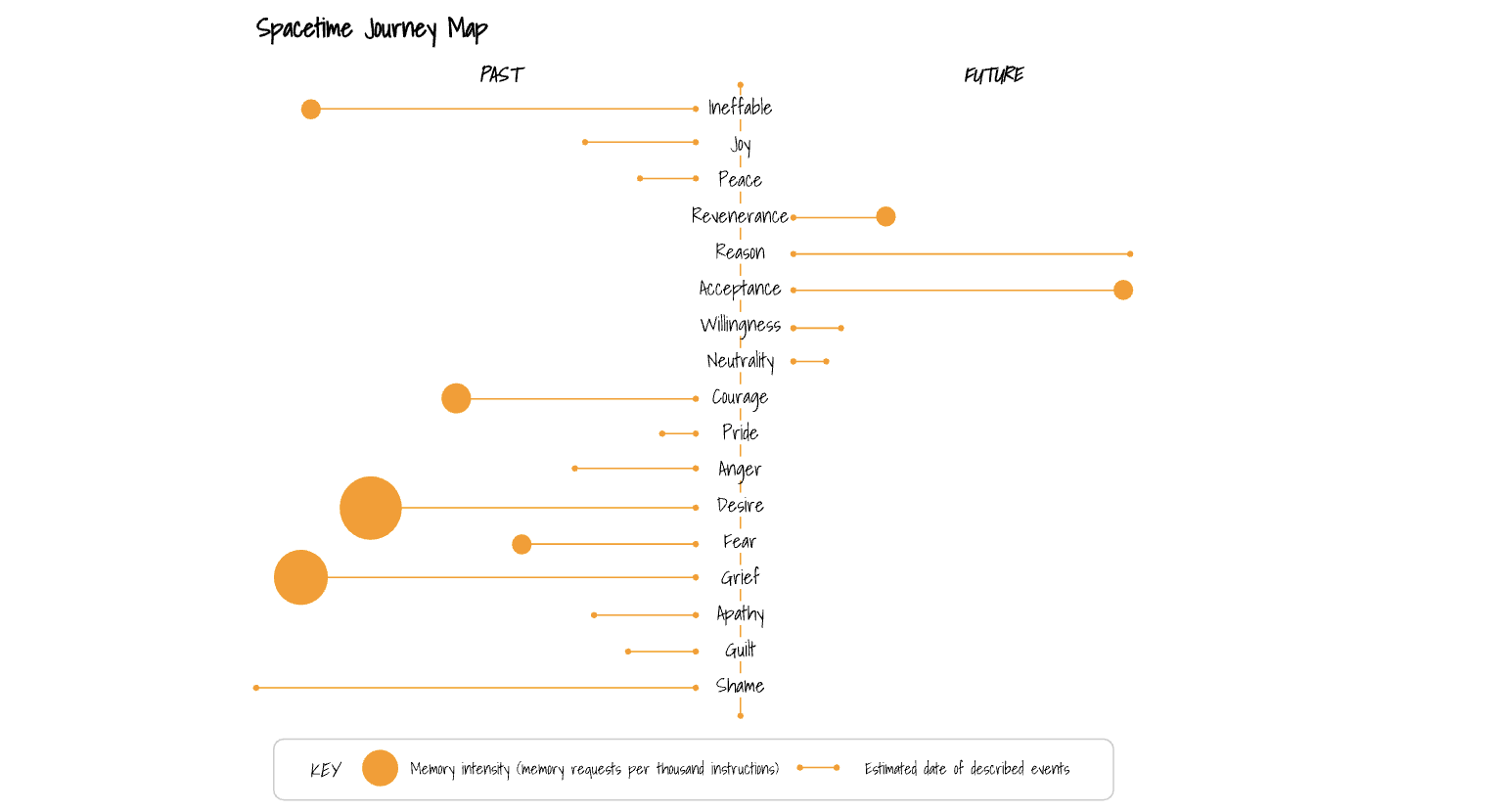On Time Travel: Blueprint for an AI-Powered Time Machine
Time travel is possible - just not in the way you imagine. We assume that humans experience objective time, but we don’t. We experience subjective time. Even when we encounter the same event, our emotional processing causes us to live in different realities. With an intangible barrier between us, it’s time to consider that time travel might start here. When we do, a blueprint for an AI-powered time machine emerges.
Time Doesn’t Work the Way You Think
Our perception of time is man-made. The weekdays come from the seven celestial objects seen in the sky - SATURN-day, SUN-day, MOON-day. The month - or MOONth - from the moon's cycle, and the year from the Earth’s orbit. Hours, minutes, and seconds come from the creation of the clock, simply designed by a monk to coordinate prayers.
We hide the abstract nature of time behind the names, ideas, and metaphors that are easily available to us. Only, once Einstein’s theory of relativity revealed that time is also space, the smooth linear structures we created were exposed as naive coping mechanisms, and time became mystical and mind-boggling again.
Think about the night sky. Everything you see in the sky belongs to the past. The moon is 1.3 light seconds away - the time it takes light, the fastest moving feature to travel - and Betelgeuse 700 light years away. Aliens could already be setting off from Andromeda to invade Earth, but we wouldn’t see them for another 2.5 million years.
We never see reality as it is, only as it was.
Time Travel is Normal
Time machines surround us. The faster inanimate objects travel, the slower they experience time. Objects like clocks on airplanes travel at a different speed to those on Earth. Traveling at ~14,000 kilometers an hour slows a clock by 8 microseconds per day - the time distortion effect is so meaningful that today’s GPS systems require time travel correcting calculations to maintain accuracy.
Our thinking patterns deny this commonality as they’re steeped in emotion, not science. The laws of physics dictate that time travel is possible but that nothing in the past or future can be altered - and yet, our conversations about time travel are often rooted in the desire to make a change.
We want to go back and save the world from Hitler, keep our exes from leaving, tell a departed one how much we loved them. Whether it’s Doctor Who or Back to the Future, our imagination and mathematics ignore the simple question needed to master our relationship with time:
Are we trying to experience the past or future, or trying to make today better?
You’re Already Time Travelling
Ironically, we make today better by accepting that we are all time travellers.
The events and traumas we experience in life shift our perspective, making us unique individuals. Whether it’s severe injustices like genocide or slavery, or the overwhelm of seemingly insurmountable problems like climate change or inequality, no two humans converse from the same place. Often we embody a combination of past attachments and future projections.
Whatever the cause, life gets easier when we accept that we’re only ever communicating with other time travellers, each relating to us from a different position.
Like the night sky, humanity might look stationary and coherent, yet we exist light years away from each other.
Our Experience of Time is Emotional
There are two types of time, subjective and objective.
We time travel and experience subjective time because, at any point, our brains actively construct our perception of time. That’s why two people can see the same event but remember it entirely differently, and why experimenters can retrospectively change the sequence of events a person remembers.
Breakthroughs in neuroscience and fMRIs show that our imagination travels to alter our perception of reality. Our real-world experiences trigger different emotional memories and as a result, different biomechanical networks. When an event occurs - like a job loss, death, or birth - our brain uses memories to predict our emotional response and then restructures reality to confirm the feeling. The more memories of a feeling, the more likely we will experience it.
Scientific discovery is telling us that the delta between subjective and objective time is emotion.
Just as color is an illusion created by the brain’s processing of electromagnetic waves, subjective time is a representation of emotion. Even as the wheel of history turns, our emotional range remains the same, suggesting that we are using a static emotional range to process the dynamism of time. Understanding this relativity may be the key to quantifying the space between us.
Time Travel is Possible for the Mind
The way we imagine ourselves and time travel is limited. The longevity of objects, like clocks on airplanes or satellites, is based on its physicality: the materials used, and the operational mechanisms. But, we’re not objects.
We are different.
We are conscious.
Researchers from the renowned Max Planck Institute suggest that our universe lives only in our perception, and once our physical bodies die, there is an infinitely larger reality. Quantum mechanics reinforces the theory. Increasingly, the scientific consensus explains that our bodies are the ultimate virtual-reality machines.
The human body - a temporary sentient structure made of 97% stardust - is the component of our nature most susceptible to time, making it the last piece that is able to move through spacetime. Following the research of Einstein, Planck, Wigner, Schrodinger, Witten, Tesla, who consider consciousness to be the core of reality, we would start by designing time machines at the level of the intangible.
Time Travel Software is Possible
Consciousness is elusive, and still, emotions provide intuitive understanding. Emotions seemingly travel - we feel other people’s sadness and joy. Emotions seemingly follow gravity - we get weighed down the tighter we hold onto them. And emotions seemingly move at different speeds - time flies when we’re having fun.
With 27% of the universe composed of a not-yet-characterized subatomic particle, it’s possible that emotions - from the Latin “energy in motion” - are a type of particle that physically exists in spacetime.
What if AI could show us where?
Leveraging generative AI could identify the location of key emotional memories that have been trapped in the past, or projected onto the future, and their memory strength. Through aggregated psychological questionnaires, research on emotional triggers, memory-intensity tests, DNA structures, and legacy challenges, AI applications could identify an individual’s emotional positioning.
The Mechanics of an AI-Powered Time Machine
An AI application that synthesizes vast learnings from psychology to biology is conceivable. But, what’s still unknown is the vehicle AI would create to determine our emotional memory location. Once realized, this AI starts by locating an individual’s emotional experience, whether in the past or future, and determining its intensity, whether large or small. It then maps the experience through spacetime, as visualized below.
With this data, we could create an AI-powered time travel machine that would nudge an individual’s emotional consciousness into experiencing the present. By focusing on moving the most intense memories, it could dissolve their power on the present. It wouldn’t eliminate negative emotions; instead, it would stop us getting stuck in their experiences. Remarkably, the technological capability required isn’t far off as the skills needed are already universal.
They are forgiveness, mercy, reconciliation, and retribution.
The technical solution is to identify trapped emotions and then move them into the present to increase consciousness. AI is the tool we can use to understand where we are today, and to apply existing collective wisdom to move us into prosperity.
Change Consciousness, Change Reality
An AI-powered time machine would move individuals into the now and experience objective time, allowing us to relate easily to others. Whether it’s partying at Woodstock, joining the feasts in Ancient Rome, or hanging out with the teens in the year 2500, individuals would be able to feel what it’s like to be in a person’s shoes without ever needing to be. Because anger in 2023 feels the same as anger in 1950.
It’s empathy, with boundaries.
With individual maps in hand, they could be used as pixels to create an image of humanity that collectively generates an estimated location of “now.” If built with the compassionate strength required to hold people through the pain of letting go and into the coordinates of the present, it could have a physical effect on the location of the particles.
This would change our reality, fundamentally changing what we choose to create, and it could do the unthinkable. It could open a traversable wormhole. One that takes us from today’s world of suffering into a world of peace.
x



